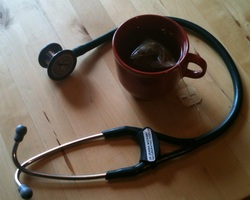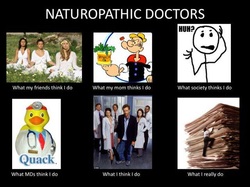
By Dr. Deanna McCrary, ND
Just as we are settling in to enjoy crisp, cool days and the festive times that the holiday season can bring, along comes an unwelcome visitor: cold-and-flu season. Arriving when there are sharp changes in weather temperatures you notice this familiar presence: a sinus-y headache, feeling tired and run-down, a scratchy throat or maybe it's a runny nose letting you know sickness has arrived at your door. How do you shut the door on this pesky, unwelcome guest, or better yet, have him pass right by your house? Here's what I do to stay sniffle-free even when surrounded by others who are battling the cold-and-flu blues:
Be Aware and Well Rested. I remain acutely aware that cold and flu season is upon us. Wherever I go I encounter some people who are sniffling and sneezing throughout their day. So I stay aware of my surroundings and take extra precautions to keep my hands washed and fingers away from nose, eyes or mouth. But a naturopathic approach is more than being aware of "germs." More importantly I make sure my body can handle whatever it may encounter. I stay aware of my body and how it is feeling. Am I getting a bit of a headache? Do I feel extra tired or run down? Is my throat scratchy? If anything seems to be "off" I immediately clear out some time in my schedule to make sure I get at least eight hours of uninterrupted sleep at night until the symptoms go away. Sometimes this is all my body needs to resist an impending cold. Taking a bit of extra time to rest at the first sign of symptoms often prevents me from getting horribly run down and sick for a week or more and is worth it. And when I am sleeping I am sure to...
Bundle Up. Every fall I go through a mourning period a few weeks after Labor Day about the fact that the tank tops and sandals are going back into storage and the sweaters, scarves, wool socks, loafers and boots come back out. Your mom was right: staying warm can help prevent a cold. Getting too cold does not directly cause a cold infection—that is accomplished by a virus called a rhinovirus—but staying warm helps your body prevent the virus from taking hold by assisting the immune system. Warm clothes, an extra blanket at night, warm herbal teas (ginger and licorice is my current favorite), hearty soups help me feel nourished and fortified on many levels.
Immune-boosting nutrients. Flu season is when I start adding in supplements like Vitamin D3, Vitamin C and beta-carotene. Eating a diet rich in colorful vegetables (especially leafy greens) and fruits can go far but if I feel run down I give my body that extra boost by adding in a high-quality multi-vitamin from a manufacturer I trust. I also make the extra effort to avoid food allergy triggers, add in a quality probiotic and fish oil to give my body the best chance to run effectively so that my immune system's reserves are saved for what they need to work on: ridding my body of viruses and bad bacteria.
Immune-boosting foods. Garlic is my number one anti-microbial wonder veggie! I have it chopped raw, as well as thrown in with cooked dishes (it's immune-boosting property, allicin, is much more active in the raw state). There is also some evidence that garlic can lower cholesterol and blood pressure as well. Yay for synergies! And when I'm keeping warm with my herbal teas I'll often add in a teaspoon or two of manuka honey which has a powerful anti-microbial effect.
Nasal lavage. Oh those little bugs love warm, moist places like our nasal passages to set up shop. A few times a week I give them a formal eviction notice by cleaning out my sinuses with a neti pot and sea-salt rinse. I resisted these for years fearing that I would somehow drown if I poured water into my nose (well, really, doesn't that fear make sense?) Once I was assured that I would not drown as, done properly, the water flows out of the other nostril, I gave it a try and have been amazed at how it can lessen the effects of a drippy nose and clear up sinus pain. It also just feels great. I now use a salt solution that has some anti-microbial essential oils added to it which further helps to keep the cold bugs at bay as well as smells really refreshing.
For prevention of a cold or flu, this is my basic strategy. It will keep me sailing through flu season if i keep at it regularly. If I neglect care and a cold hits, I add in several other therapies such as a specific herbal protocol and hydrotherapy techniques that often greatly reduce the length and severity of the cold.
Not all of these strategies will be the best course of action for everyone and no one should read this article as a personal recommendation of care for themselves. Sometimes your symptoms may indicate something more serious than a cold and a visit with a medical professional may be in order. Consult a physician if any of the following apply: difficulty breathing, chills or dizziness, a fever above 101.5 degrees for two days, a severe headache or stiff neck along with a high fever, or if your symptoms have not improved after a week.
Keeping our bodily "terrain" in tip-top shape is the best course of action to prevent infections from taking up residence and spoiling our holiday fun.
Keep warm and carry on!
© Deanna McCrary, ND and LifeJOY Natural Medicine, 2013. Unauthorized use and/or duplication of this material without express and written permission from this blog’s author and/or owner is strictly prohibited. Excerpts and links may be used, provided that full and clear credit is given to Dr. Deanna McCrary, ND and LifeJOY Natural Medicine with appropriate and specific direction to the original content.
Just as we are settling in to enjoy crisp, cool days and the festive times that the holiday season can bring, along comes an unwelcome visitor: cold-and-flu season. Arriving when there are sharp changes in weather temperatures you notice this familiar presence: a sinus-y headache, feeling tired and run-down, a scratchy throat or maybe it's a runny nose letting you know sickness has arrived at your door. How do you shut the door on this pesky, unwelcome guest, or better yet, have him pass right by your house? Here's what I do to stay sniffle-free even when surrounded by others who are battling the cold-and-flu blues:
Be Aware and Well Rested. I remain acutely aware that cold and flu season is upon us. Wherever I go I encounter some people who are sniffling and sneezing throughout their day. So I stay aware of my surroundings and take extra precautions to keep my hands washed and fingers away from nose, eyes or mouth. But a naturopathic approach is more than being aware of "germs." More importantly I make sure my body can handle whatever it may encounter. I stay aware of my body and how it is feeling. Am I getting a bit of a headache? Do I feel extra tired or run down? Is my throat scratchy? If anything seems to be "off" I immediately clear out some time in my schedule to make sure I get at least eight hours of uninterrupted sleep at night until the symptoms go away. Sometimes this is all my body needs to resist an impending cold. Taking a bit of extra time to rest at the first sign of symptoms often prevents me from getting horribly run down and sick for a week or more and is worth it. And when I am sleeping I am sure to...
Bundle Up. Every fall I go through a mourning period a few weeks after Labor Day about the fact that the tank tops and sandals are going back into storage and the sweaters, scarves, wool socks, loafers and boots come back out. Your mom was right: staying warm can help prevent a cold. Getting too cold does not directly cause a cold infection—that is accomplished by a virus called a rhinovirus—but staying warm helps your body prevent the virus from taking hold by assisting the immune system. Warm clothes, an extra blanket at night, warm herbal teas (ginger and licorice is my current favorite), hearty soups help me feel nourished and fortified on many levels.
Immune-boosting nutrients. Flu season is when I start adding in supplements like Vitamin D3, Vitamin C and beta-carotene. Eating a diet rich in colorful vegetables (especially leafy greens) and fruits can go far but if I feel run down I give my body that extra boost by adding in a high-quality multi-vitamin from a manufacturer I trust. I also make the extra effort to avoid food allergy triggers, add in a quality probiotic and fish oil to give my body the best chance to run effectively so that my immune system's reserves are saved for what they need to work on: ridding my body of viruses and bad bacteria.
Immune-boosting foods. Garlic is my number one anti-microbial wonder veggie! I have it chopped raw, as well as thrown in with cooked dishes (it's immune-boosting property, allicin, is much more active in the raw state). There is also some evidence that garlic can lower cholesterol and blood pressure as well. Yay for synergies! And when I'm keeping warm with my herbal teas I'll often add in a teaspoon or two of manuka honey which has a powerful anti-microbial effect.
Nasal lavage. Oh those little bugs love warm, moist places like our nasal passages to set up shop. A few times a week I give them a formal eviction notice by cleaning out my sinuses with a neti pot and sea-salt rinse. I resisted these for years fearing that I would somehow drown if I poured water into my nose (well, really, doesn't that fear make sense?) Once I was assured that I would not drown as, done properly, the water flows out of the other nostril, I gave it a try and have been amazed at how it can lessen the effects of a drippy nose and clear up sinus pain. It also just feels great. I now use a salt solution that has some anti-microbial essential oils added to it which further helps to keep the cold bugs at bay as well as smells really refreshing.
For prevention of a cold or flu, this is my basic strategy. It will keep me sailing through flu season if i keep at it regularly. If I neglect care and a cold hits, I add in several other therapies such as a specific herbal protocol and hydrotherapy techniques that often greatly reduce the length and severity of the cold.
Not all of these strategies will be the best course of action for everyone and no one should read this article as a personal recommendation of care for themselves. Sometimes your symptoms may indicate something more serious than a cold and a visit with a medical professional may be in order. Consult a physician if any of the following apply: difficulty breathing, chills or dizziness, a fever above 101.5 degrees for two days, a severe headache or stiff neck along with a high fever, or if your symptoms have not improved after a week.
Keeping our bodily "terrain" in tip-top shape is the best course of action to prevent infections from taking up residence and spoiling our holiday fun.
Keep warm and carry on!
© Deanna McCrary, ND and LifeJOY Natural Medicine, 2013. Unauthorized use and/or duplication of this material without express and written permission from this blog’s author and/or owner is strictly prohibited. Excerpts and links may be used, provided that full and clear credit is given to Dr. Deanna McCrary, ND and LifeJOY Natural Medicine with appropriate and specific direction to the original content.






 RSS Feed
RSS Feed